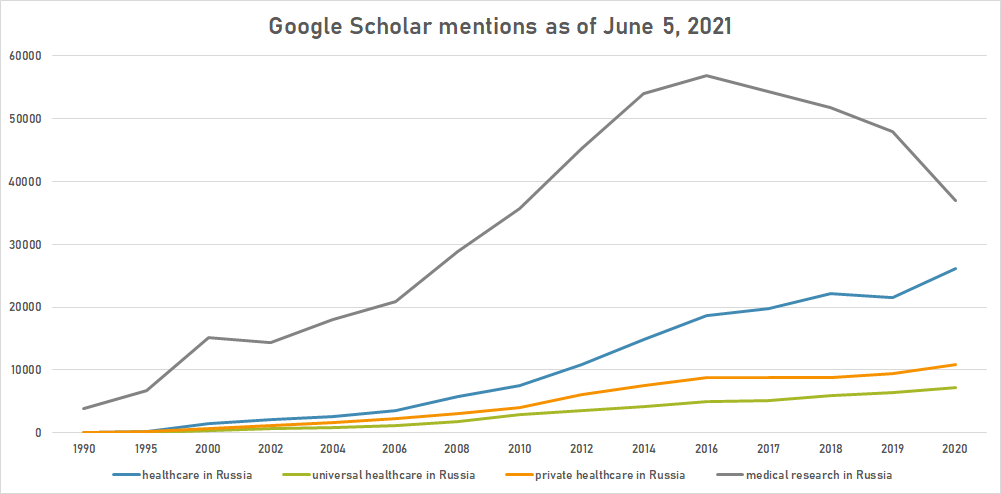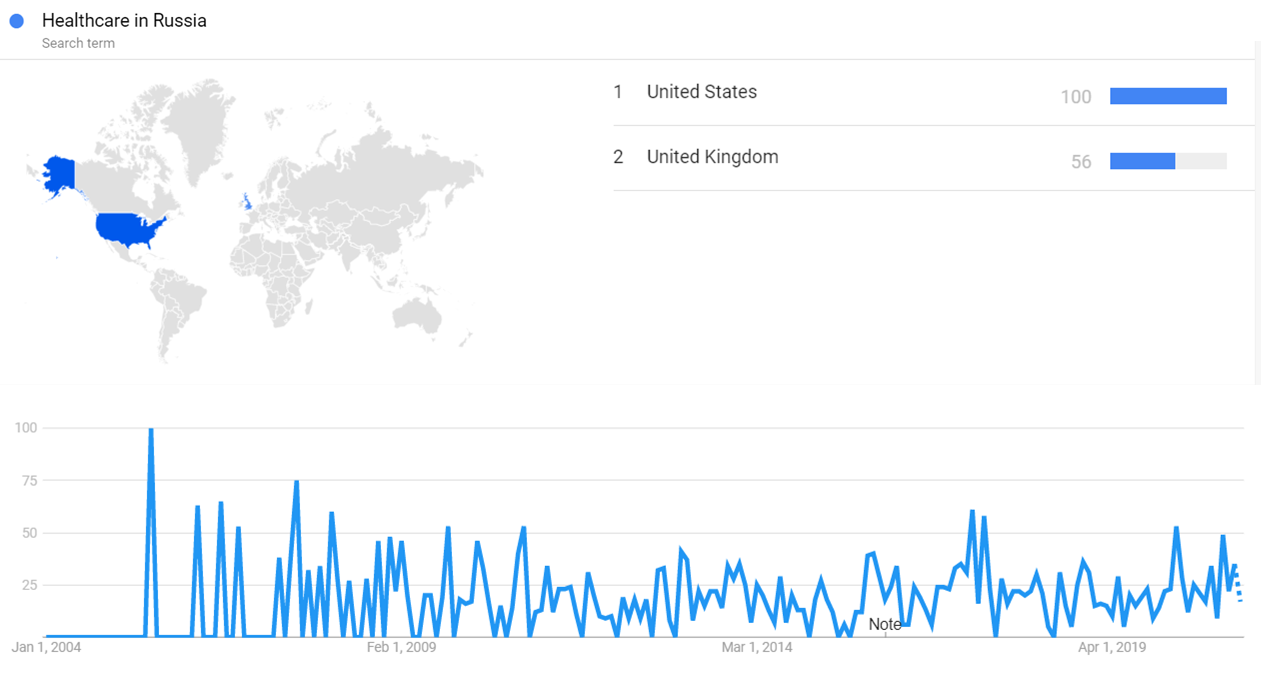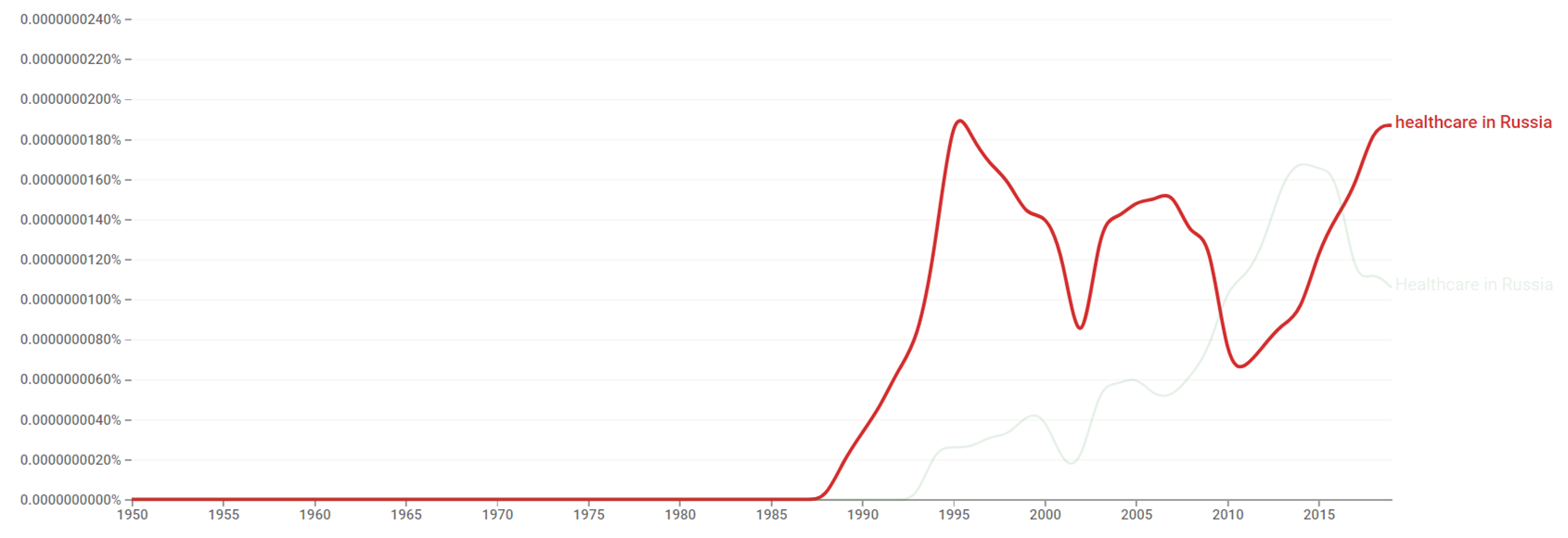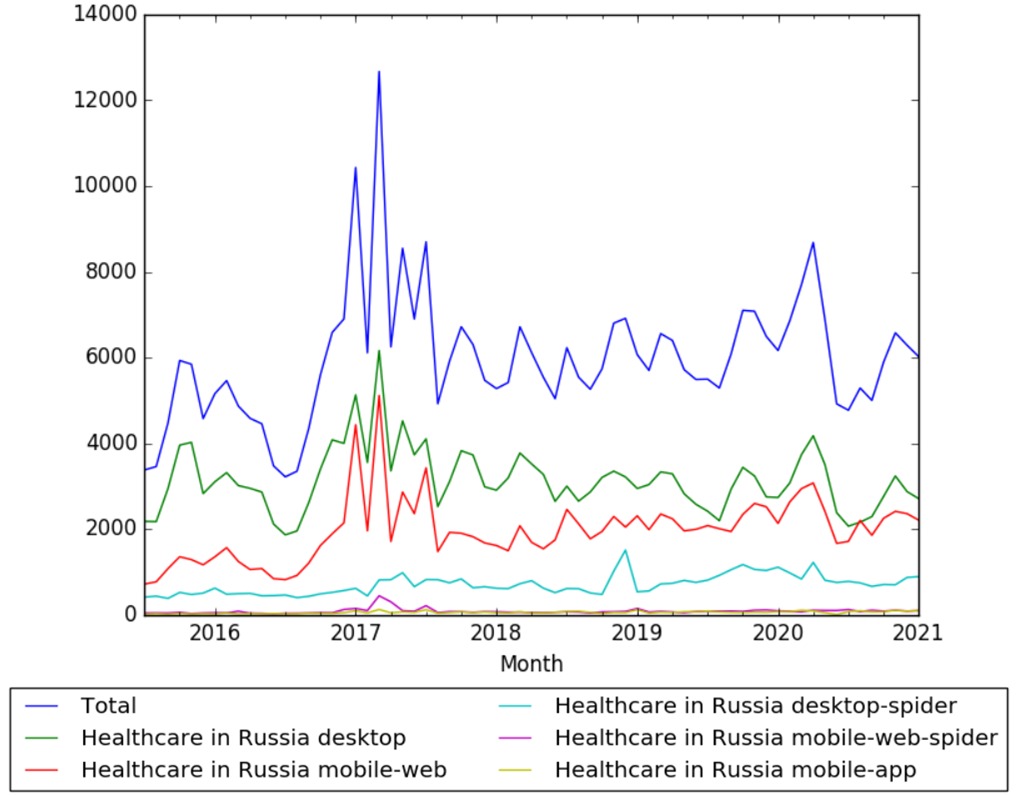Timeline of healthcare in Russia
Jump to navigation
Jump to search
The content on this page is forked from the English Wikipedia page entitled "Timeline of healthcare in Russia". The original page still exists at Timeline of healthcare in Russia. The original content was released under the Creative Commons Attribution/Share-Alike License (CC-BY-SA), so this page inherits this license.
This is a timeline of healthcare in Russia. Major events such as crises, policies and organizations are described.
Big picture
| Year/period | Key developments |
|---|---|
| Tsarist Russia | During the times of Slavery in Russia, the health conditions of the population range starting from a calamitous level. Generally, lack of preventive measures against diseases results in a very high mortality rate among both adults and children. Severe sanitary neglect, filth and unhygienic living conditions prevail. Six epidemis of Asiatic cholera strike Russia and claim over 2 million human lifes in the country.[1] |
| 1922–1991 | Soviet Russia builds a totally socialist health care model (Semashko system) with a centralized, integrated, hierarchically organized with the government providing state-funded health care to all citizens. All health personnel are state employees. Control of communicable diseases have priority over non-communicable ones. On the whole, the system tends to primary care, and places much emphasis on specialist and hospital care. Universal healthcare is established in 1930s and 1940s as part of rapid modernization and industrialization.[2] |
| 1991–2000 | Period following the dissolution of the Soviet Union. Russia’s statist political economy implodes, and its healthcare system is thrown into crisis. Public expenditures on health decline dramatically, following a decade-long decline in the economy. Health indicators plummet. Male life expectancy decline to below 60 years. Infectious diseases re-emerge and spread, and even childhood immunization programs collapse temporarily in parts of the country.[2] |
| 2000–2010 | The Russian healthcare system recovers substantially in terms of financing, performance, organizational coherence and health outcomes. Rapid growth the economy from 2000 to 2007 allows growth in spending for public healthcare[2][3] and by 2006 the figure exceeds the pre-1991 level in real terms.[3] Also there's an increase in life expectancy from 1991-93 levels, and a decrease in infant mortality from 18.1 in 1995 to 8.4 in 2008.[4] By 2010, the worst effects on health indicators reverse.[2] However, health in Russia remains well below the levels of developed countries. |
| 2010–present | Today, Russia's healthare system has recovered substantially from the crisis conditions of the 1990s. However, it is still characterized by its low efficiency, with outcomes similar to those of countries far less developed. As of 2016, life expectancy in Russia is lower that those of countries like Belize, Nepal and Bangla Desh.[2][5] |
Timeline
| Year/period | Type of event | Event | Location |
|---|---|---|---|
| 1601–1603 | Crisis | The Russian famine of 1601–03 is considered the Russia's worst famine in terms of proportional effect on the population, with deceases estimated at two million people. The famine is part of worldwide record cold winters and crop disruption, which in 2008 geologists linked to the 1600 volcanic eruption of Huaynaputina in Peru.[6] | |
| 1748 | Organization | City hospital No. 40 is founded.[7] | Saint Petersburg |
| 1758 | Organization | I.M. Sechenov First Moscow State Medical University is established.[8] | Moscow |
| 1770–1772 | Crisis | 1770–1772 Russian plague. It is the last massive outbreak of plague in central Russia, claiming between 52 and 100 thousand lives in Moscow alone (1/6 to 1/3 of its population). Originated in Moldova.[9] | Central Russia, Moldova, Ukraine |
| 1814 | Organization | Kazan State Medical University is founded.[10] | Kazan |
| 1891–1892 | Crisis | Russian famine of 1891–2. Originated along the Volga River, it spreads as far as the Urals and Black Sea. Between fourteen to twenty million people are estimated to be affected, of which 375,000 to 400,000 died, mostly of disease.[11] | Nizhny Novgorod Oblast, Ryazan Oblast, Ryazan Oblast, Republic of Tatarstan, Ulyanovsk Oblast, Saratov Oblast, Penza Oblast, Samara Oblast and Tambov Oblast. |
| 1897 | Organization | First Pavlov State Medical University of St. Petersburg is established.[12] | Saint Petersburg |
| 1906 | Organization | The Russian National Research Medical University is established.[13] | Moscow |
| 1910 | Organization | Lesnoye Sanatorium is founded. Its main focus is tuberculosis treatment.[14] | Tolyatti |
| 1915 | Organization | The Anglo-Russian Hospital is founded. It is set up during the First World War. Closed in 1918.[15] | Petrograd |
| 1920 | Organization | Nizhny Novgorod State Medical Academy is founded.[16] | Nizhny Novgorod |
| 1920 | Organization | The Medical Faculty of the Siberian Institute of Veterinary Medicine and Zoology is founded. Today Omsk Medical Academy.[17] | Omsk |
| 1921–1922 | Crisis | 1921–22 famine in Tatarstan. It is calculated that more than 2,000,000 peasants starved, particularly in Arsk, Sviyazhsk, Mamadysh, Menzelinsk, Spassk, Tetyushi and Chelny cantons.Template:Fix/category[citation needed] | Tatarstan |
| 1921 | Organization | The Serbsky State Scientific Center for Social and Forensic Psychiatry is founded. The institution has garnered negative publicity because many Soviet dissidents were examined there and then sent to psychiatric hospitals.Template:Fix/category[citation needed] | Moscow |
| 1922 | Organization | Moscow State University of Medicine and Dentistry is founded.[18] | Moscow |
| 1925 | Organization | Saint Petersburg State Pediatric Medical University is established.[19] | Saint Petersburg |
| 1935 | Organization | Kursk State Medical University is established.[20] | Kursk |
| 1935 | Organization | Novosibirsk State Medical Academy is founded as Novosibirsk State Medical University.[21] | Novosibirsk |
| 1935 | Organization | Volgograd State Medical University is founded.[22] | Volgograd |
| 1936 | Organization | Leningrad Dental Institute is founded. Later transferred to Tver and renamed Tver State Medical Academy.[23] | Saint Petersburg |
| 1938 | Publication | Military Medical Business (Военно Санитарное Дело) is launched as a professional medical journal of the Worker's and Peasant's Red Army.[24] | |
| 1944 | Organization | The USSR Academy of Medical Sciences is founded.[25] | |
| 1944 | Organization | Yaroslavl State Medical Academy is founded.[26] | Yaroslavl |
| 1947 | Organization | The Federal Biomedical Agency is formed. It is the national public health institute of the Russian Federation.[27] | Moscow |
| 1951 | Organization | The St Petersburg Psychiatric Hospital of Specialized Type with Intense Observation is founded.[28] | St Petersburg |
| 1955 | Publication | Zdoroviye (Template:Lang-ru; literally "Health") is founded as a health magazine.[29] | |
| 1955 | Policy | Abortion is legalized for medical reasons (and for overall reasons in 1968).[30] | |
| 1956 | Organization | Bakulev Scientific Center of Cardiovascular Surgery is founded. It is one of the leading cardiovascular surgery-related facilities of the Russian Federation.[31] | Moscow |
| 1956 | Organization | Vladivostok State Medical University is established.[32] | Vladivostok |
| 1957 | Organization | The Central Clinical Hospital of the Presidential Administration of the Russian Federation is founded.[33] | Moscow |
| 1971 | Organization | The Russian Ilizarov Scientific Center for Restorative Traumatology and Orthopaedics is founded. The center is the largest in the world that specializes in the treatment of complex orthopaedic problems.[34] | Kurgan |
| 1977 | People's Doctor of the USSR (Template:Lang-ru) is established as an honorary title conferred by the Supreme Soviet's presidency on behalf of the Ministry of Health. Bestowed to individual medical doctors and nurses but also to health care structures as general hospitals, sanatoriums, maternity wards or preventive medicine centers.Template:Fix/category[citation needed] | ||
| 1979 | Crisis | Sverdlovsk anthrax leak. Spores of anthrax are accidentally released from a military facility. This accident is sometimes called "biological Chernobyl". Approximately 100 deaths are estimated.[35] | Yekaterinburg |
| 1987 | Policy | After the first case of AIDS is confirmed in Russia, the Supreme Soviet of the Soviet Union passes the strictest anti-AIDS law in the world, making the knowing transmittal of the infection a criminal offense punishable by up to eight years in jail.[30] | |
| 1988 | Organization | Fyodorov Eye Microsurgery Complex is founded by Russian eye surgeon Svyatoslav Fyodorov.[36] | Moscow |
| 1988 | Organization | The Fyodorov Eye Microsurgery Complex is founded as a clinical and research ophthalmological center.[37] | Moscow. Branches in Cheboksary, Irkutsk, Kaluga, Khabarovsk, Krasnodar, Novosibirsk, Orenburg, Saint Petersburg, Tambov, Volgograd, and Yekaterinburg. |
| 1989 | Organization | The Independent Psychiatric Association of Russia is founded. It first psychiatric association in the USSR not controlled by the State.[38] | Moscow |
| 1992 | Organization | The USSR Academy of Medical Sciences is succeeded by the newly founded Russian Academy of Medical Sciences.[39] | |
| 1992 | Organization | The MSU Faculty of Fundamental Medicine is founded.[40] | Moscow |
| 1993 | Policy | Article 41 of the 1993 constitution confirms a citizen's right to healthcare and medical assistance free of charge.[41] | |
| 1993 | Policy | The 89 Russian regions share responsibility for health policy with the federal government. Nine supra-regional economic groupings are formed with no political or administrative power.[42] | |
| 1995 | Policy | New law stipulates that all visitors remaining more than three months must provide documentation proving that they are not infected with HIV.[30] | |
| 1996 | Policy | Government health facilities are allowed to offer private services.[43] | |
| 2001 | Organization | Humanitarian Action is founded as a non-governmental charitable organization. It carries out programs and outreach for HIV/AIDS prevention, and aiding street children, intravenous drug users, and sex workers.[44] | Saint Petersburg |
| 2003 | Organization | The Northern Dimension Partnership in Public Health and Social Well-being (NDPHS) is formed as a transnational cooperative effort of nine governments, the European Commission and eight international organisations to tackle challenges regarding health and social well-being issues in the Northern Dimension area.[45] | Estonia, Finland, Germany, Latvia, Lithuania, Norway, Poland, Russia, Sweden |
| 2003 | Organization | Saint Petersburg Children’s Hospice is founded as a non-profit institution of pediatric palliative care for minors under 18 years.[46] | Saint Petersburg |
| 2005 | Campaign | Following a relatively high rate of infection, the Russian government starts a massive increases in expenditure against HIV/AIDS, and a network of regional AIDS centers is established.[2] | |
| 2006 | The Minister of Health Mikhail Zurabov and Deputy Chairman of the State Duma Committee for Health Protection Nikolai Gerasimenko propose reinstating the Soviet-era tax on childlessness, which ended in 1992.[47] | ||
| 2006 | Campaign | The Russian government launches a national projects plan that approved an additional $3.2 billion in spending on health care, covering the salaries of doctors and nurses, the purchase of medical equipment, and the construction of eight high-tech medical centers in Russia’s outlying regions.[36] | |
| 2007 | Report | Russia experiences the highest birth rate since the collapse of the USSR.[48] | |
| 2010 | Policy | The Russian Government adopts a National Anti-Tobacco Policy Concept, based on ratification of the WHO 2008 Framework Convention on Tobacco Control.[2] | |
| 2011 | Russian Prime Minister Vladimir Putin announces a large-scale health-care reform and pledges to allocate more than 300 billion rubles ($10 billion) in the next few years to improve health care in the country.[49] | ||
| 2011 | Policy | Private providers start to provide services to the state-insured.[43] | |
| 2011 | Organization | The Federal Center of Neurosurgery is founded.[50] | Tyumen |
| 2012 | Organization | The Ministry of Health of the Russian Federation succeeds the former Ministry of Health and Social Development.[51] | Moscow |
| 2012 | Policy | Russian Prime Minister Vladimir Putin signs the May Decrees which includes a plan to double the wages of healthcare staff by 2018 and gradual privatization of state health services.[43] | |
| 2013 | Development | United Medical Information and Analytical System of Moscow (EMIAS) is released as a complex information system that automatises the booking of hospital visits and work of medical professionals.[52] | Moscow |
| 2014 | Wage rises in Moscow leads to the closure of 15 hospitals and 7000 redundancies.[43] | Moscow | |
| 2016 | Report | Life expectancy in Russia is estimated at 67.42 years, being ranked 171th out of 228 political subdivisions.[5] |
Numerical and visual data
Google Scholar
The following table summarizes per-year mentions on Google Scholar as of June 5, 2021.
| Year | healthcare in Russia | universal healthcare in Russia | private healthcare in Russia | medical research in Russia |
|---|---|---|---|---|
| 1990 | 57 | 15 | 39 | 3,910 |
| 1995 | 268 | 90 | 164 | 6,740 |
| 2000 | 1,490 | 407 | 624 | 15,200 |
| 2002 | 2,120 | 733 | 1,180 | 14,300 |
| 2004 | 2,560 | 896 | 1,580 | 18,000 |
| 2006 | 3,600 | 1,220 | 2,210 | 20,900 |
| 2008 | 5,780 | 1,800 | 3,080 | 28,800 |
| 2010 | 7,590 | 2,910 | 4,030 | 35,700 |
| 2012 | 10,900 | 3,470 | 6,160 | 45,200 |
| 2014 | 14,900 | 4,140 | 7,480 | 54,000 |
| 2016 | 18,600 | 4,970 | 8,800 | 56,900 |
| 2017 | 19,800 | 5,200 | 8,740 | 54,400 |
| 2018 | 22,100 | 5,890 | 8,800 | 51,800 |
| 2019 | 21,600 | 6,400 | 9,420 | 48,000 |
| 2020 | 26,200 | 7,260 | 10,800 | 37,000 |

Google Trends
The image below shows Google Trends data for Healthcare in Russia (Search term) from January 2004 to February 2021, when the screenshot was taken. Interest is also ranked by country and displayed on world map.[53]

Google Ngram Viewer
The chart below shows Google Ngram Viewer data for Healthcare in Russia, from 1950 to 2019.[54]

Wikipedia Views
The chart below shows pageviews of the English Wikipedia article Healthcare in Russia, on desktop, mobile-web, desktop-spider, mobile-web-spider and mobile app, from July 2015 to January 2021.[55]

See also
- Healthcare in Russia
- Timeline of healthcare in Germany
- Timeline of healthcare in France
- Timeline of healthcare in Italy
References
- ↑ Henze, Charlotte E. Disease, Health Care and Government in Late Imperial Russia: Life and Death. Retrieved 7 November 2016.
- ↑ 2.0 2.1 2.2 2.3 2.4 2.5 2.6 "Constraints on Universal Health Care in the Russian Federation" (PDF). Retrieved 28 October 2016.
- ↑ 3.0 3.1 "Public Spending in Russia for Healthcare" (PDF).
- ↑ "Russian State Institute of Demography".
- ↑ 5.0 5.1 "Life expectancy". Retrieved 6 November 2016.
- ↑ Perkins, S. (2009). "Disaster goes global: The eruption in 1600 of a seemingly quiet volcano in peru changed global climate and triggered famine as far away as Russia". Science News. 174 (5): 16–21. doi:10.1002/scin.2008.5591740519.
- ↑ "City hospital No. 40". Retrieved 7 November 2016.
- ↑ "I.M. SECHENOV FIRST MOSCOW STATE MEDICAL UNIVERSITY". Retrieved 7 November 2016.
- ↑ Alexander, John T. (1974). "Catherine II, Bubonic Plague, and the Problem of Industry in Moscow". American Historical Review. 79 (3): 637–71. doi:10.2307/1867892. JSTOR 1867892.
- ↑ "Kazan State Medical University". Retrieved 7 November 2016.
- ↑ "The Russian Famine of 1891-92". Retrieved 27 October 2016.
- ↑ "First Pavlov State Medical University of St Petersburg". Retrieved 7 November 2016.
- ↑ "Russian National Research Medical University". Retrieved 7 November 2016.
- ↑ "Lesnoye Sanatorium". Retrieved 26 October 2016.
- ↑ "Anglo-Russian hospital". Retrieved 7 November 2016.
- ↑ "NIZHNY NOVGOROD STATE MEDICAL ACADEMY". Retrieved 7 November 2016.
- ↑ "Omsk Medical Academy". Retrieved 7 November 2016.
- ↑ "Moscow State University of Medicine and Dentistry". Retrieved 29 October 2016.
- ↑ "Saint Petersburg State Pediatric-Medical University". Retrieved 8 November 2016.
- ↑ "Kursk State Medical University". Retrieved 8 November 2016.
- ↑ "Novosibirsk State Medical University". Retrieved 8 November 2016.
- ↑ "Volgograd State Medical University". Retrieved 8 November 2016.
- ↑ "Tver State Medical University". Retrieved 8 November 2016.
- ↑ 1938, № 11 Военно Санитарное Дело, Москва
- ↑ "Academy of Medical Sciences of the USSR". Public Health Rep. 75: 840. September 1960. PMC 1929489. PMID 19316366.
- ↑ "General Information About Yaroslavl State Medical University". Retrieved 8 November 2016.
- ↑ "Federal Biomedical Agency". Retrieved 8 November 2016.
- ↑ "St Petersburg Psychiatric Hospital of Specialized Type with Intense Observation". Retrieved 26 October 2016.
- ↑ "Media Use in Putin's Russia". Journal of Communist Studies and Transition Politics. 24: 365–385. doi:10.1080/13523270802267906. Retrieved 27 October 2016.
- ↑ 30.0 30.1 30.2 "Health and Health Care in Russia and the Former Soviet Union". Retrieved 28 October 2016.
- ↑ "Bakulev". Retrieved 8 November 2016.
- ↑ "Vladivostok State Medical University". Retrieved 8 November 2016.
- ↑ "Central". Retrieved 8 November 2016.
- ↑ "Russian Ilizarov Scientific Center for Restorative Traumatology and Orthopaedics". Retrieved 8 November 2016.
- ↑ Ken Alibek and S. Handelman. Biohazard: The Chilling True Story of the Largest Covert Biological Weapons Program in the World - Told from Inside by the Man Who Ran it. 1999. Delta (2000) ISBN 0-385-33496-6 [1].
- ↑ 36.0 36.1 "Healthcare in Russia". Retrieved 28 October 2016.
- ↑ "Fyodorov Eye Microsurgery Complex". Retrieved 28 October 2016.
- ↑ "Independent Psychiatric Association of Russia". Retrieved 28 October 2016.
- ↑ "Russian Academy of Medical Sciences". Retrieved 27 October 2016.
- ↑ "Faculty of Fundamental Medicine". Retrieved 8 November 2016.
- ↑ "The Constitution of the Russian Federation".
- ↑ "Reforming the Russian health-care system" (PDF). Retrieved 28 October 2016.
- ↑ 43.0 43.1 43.2 43.3 Britnell, Mark (2015). In Search of the Perfect Health System. London: Palgrave. p. 83. ISBN 978-1-137-49661-4.
- ↑ "Humanitarian action". Retrieved 8 November 2016.
- ↑ "NDPHS". Retrieved 8 November 2016.
- ↑ "Saint-Petersburg Children's Hospice". Retrieved 7 November 2016.
- ↑ "Childless Russian families to pay taxes for their social inaction," http://english.pravda.ru/russia/economics/15-09-2006/84467-childless-0 (accessed January 3, 2010.)
- ↑ "Russian policies ignite unprecedented birth rate in 2007". Retrieved 28 October 2016.
- ↑ "Putin says Russia needs major health care reform".
- ↑ "Federal Center of Neurosurgery (Tyumen)". Retrieved 8 November 2016.
- ↑ "Russian Health Ministry Orders". Retrieved 8 November 2016.
- ↑ "Emias". Retrieved 28 October 2016.
- ↑ "Healthcare in Russia". Google Trends. Retrieved 25 February 2021.
- ↑ "Healthcare in Russia". books.google.com. Retrieved 25 February 2021.
- ↑ "Healthcare in Russia". wikipediaviews.org. Retrieved 24 February 2021.